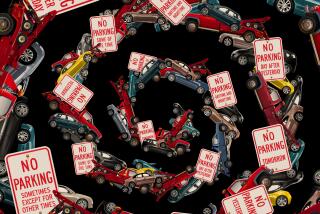Along the Open Road
LAGUNA NIGUEL — Heidi Nov usually isn’t lead-footed.
She drives a Mercedes station wagon for its safety, straps her 6-year-old in the back seat and hasn’t had a ticket for nine years.
But earlier this month, the San Joaquin Hills Transportation Corridor got the best of her. When her speedometer hit 75, the CHP officer was right behind her.
Nov isn’t alone. Since the toll road opened two weeks ago, the California Highway Patrol says, many drivers seem to have lost track of the fact that the scenic, uncrowded freeway is not an open country road.
“For me, the corridor is a lifesaver. I love it,” said Nov of Laguna Niguel. “But I wish there were yellow flashing lights reminding people to slow down, because it’s so easy to speed there. First, it’s not crowded and it’s so pretty out there, so I guess it’s harder to pay attention. Then there’s a point on the road where it’s just all downhill.”
While the new 15-mile route between San Juan Capistrano and Newport Beach provides drivers with a convenient alternative to the Santa Ana and San Diego freeways, it also invites some havoc.
“We’ve had people backing away from the toll plaza because they didn’t realize they were entering a toll road, or they accidentally went to the ‘Fastrak’ side without a transponder,” California Highway Patrol Sgt. Roger Fuller said. “One of our officers saw a guy make a U-turn at a tollbooth and ended up going the wrong way on the freeway. . .
“As far as speeding goes, it’s really bad out there,” he said. “We’ve caught several people going in excess of 100 miles an hour.”
On opening day on Nov. 21, at least 14 accidents were reported on the tollway, according to the CHP.
“It was raining that day, but that was not the main reason people were getting into accidents,” Fuller said. “The main reason was the speed of the drivers.”
CHP Officer Wendy Camilleri, who patrols the area, said most people were traveling at about 70 mph that day, when slick roads prevented her from going faster than 50 mph.
“They were just flying,” she said. “People were going 65-70 in the rain, and because of the low clouds, visibility was maybe a few hundred feet.
“It’s really dangerous out there when it rains.”
The number of reported accidents and speeding citations issued was not readily available, but five CHP officers interviewed earlier this month said that, in general, motorists are behaving more recklessly on the tollway than other freeways.
“I think traffic is lighter out there, and people just take full advantage of that,” Fuller said.
Officials with the Transportation Corridor Agencies, which built and operate the road, said many drivers are not familiar with the fledgling tollway, and they make mistakes.
For instance, at two northbound exits, Newport Coast Drive and Bonita Canyon Road, exact change is required because there are no attendants at those tollbooths.
“A lot of people don’t have exact change, so they throw in a dollar bill, and that eventually jams up the machine for the people behind them,” said Michele Sperl-Miller, a spokeswoman for the agencies.
“We don’t want people to do that. We suggest that they go ahead and violate this time, and what will happen is they’ll receive a letter by mail asking them to pay that toll.”
For the next few months, drivers will receive warnings and requests to pay their tolls. Thereafter, the fine will be $76.
“It’s a new facility, and a lot of people are still trying to figure it out,” Sperl-Miller said. “And although we have encountered some problems, they are so minor compared to the overall success of the tollway.”
Agency officials estimated that about 70,000 drivers will be using the road daily by the end of 1997, and said current figures hover around 43,000.
By the year 2000, $58 million must be generated annually from tolls, which range from 25 cents to $2, to meet the toll road’s debt, authorities said. That’s about 41 million car trips annually, or 112,000 daily.
Sperl-Miller said authorities are confident that goal will be met. The number of cars going through the toll booths is rising daily, and the agencies have been getting about 500 requests per day for transponders, which are read automatically as cars pass through the tollbooths.
In fact, commuters are having to wait one or two weeks for their transponders, as opposed to about two days before the tollway opened, Sperl-Miller said.
“Overall, we’re very pleased with the public’s response,” she said.
Doug Price is among those who count the tollway as a blessing. His morning commute used to be a 20-minute obstacle course that tested his skills to spot a freeway traffic jam beforehand and an inside knowledge of the detours that would take him around it.
“I used to take [Interstate 5] and exit Oso Parkway, where traffic usually backs up,” said Price, an assistant principal at Aliso Viejo Middle School who lives in San Juan Capistrano. “Then if I thought traffic is going to be really bad, then I take Golden Lantern to Moulton Parkway to Windsong and down to the school.”
That morning battle has turned into a peaceful drive that approaches “eerie,” Price said.
“I’m saving gas, and it’s sure worth the time and the aggravation. I’m not a happy camper when it comes to traffic jams.”
More to Read
Sign up for Essential California
The most important California stories and recommendations in your inbox every morning.
You may occasionally receive promotional content from the Los Angeles Times.










